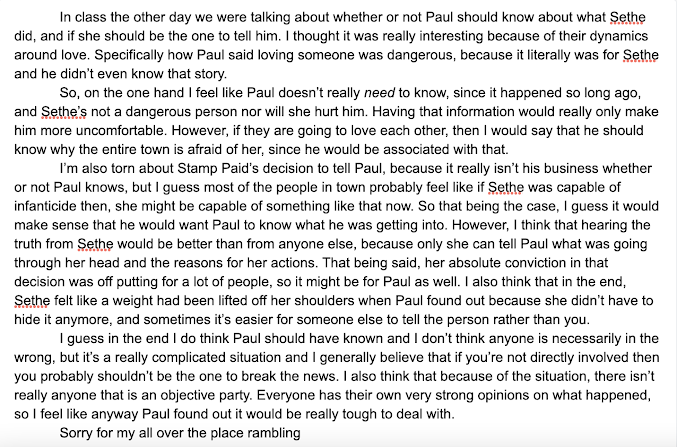The Sambo Doll and the Coin Bank
I thought the Sambo doll and the coin bank played really important roles in the book and deeply affected the narrator.
When the narrator first finds the coin bank, it’s a little confusing because I wasn’t sure how he could stay in Mary’s house for so long without noticing it in his room. However, as the coin bank is a depiction of an enslaved man trying to get on a white man’s good side, I think it’s fitting that he finds the coin bank right before he starts working for the Brotherhood. Not that the narrator is trying to get on all the white men’s good sides, but that he’s going to work for them knowing absolutely nothing about their moral beliefs or goals. He’s enticed by the higher pay level, eventually at the cost of his own sanity. I also think that the coin bank represents how stereotypes follow you wherever you go, and no matter how hard you try to not fit into them, just by having black skin people will associate you with them. He tries his hardest to get rid of the disgusting coin bank but cannot because people keep bringing it back to him. It seems to me like the narrator is aware of this.
I also thought the Sambo doll represented the narrator pretty well at the time that he saw it. Right when he’s getting screwed over most by the Brotherhood he sees another brother controlling a doll resembling an enslaved man trying to entertain white people. The dynamics of that are very strange, as the doll represents what Tod Clifton was doing by making him dance. The brotherhood had such a hold on the narrator at that moment, they moved him away from the problem he was passionate about and moved him to a problem he knew nothing about. They controlled him like a puppet for their own personal gain, which is exactly what Todd Clifton was doing with the Sambo doll, and that is what the Sambo doll originally meant to do in the first place. And after the narrator saw the doll he watched Clifton get shot which would be extremely traumatizing, and would probably forever associate the Sambo doll with that death.

I agree with the connections you made between the doll and the coin bank, and they are definitely more than just simple objects. I find the part of the story where the coin bank keeps on returning to the narrator kind of surreal. It seems to be glaring message and I think your interpretation of it being racism following him wherever he goes to be accurate.
ReplyDeleteI also think it is interesting how the narrator is unable to get rid of these objects once he is in possession of them, especially since in the manhole he is forced to burn everything else from is past, destroying them instantly. I agree with your point that this seems to be representative of the fact that racism will always follow him, and I think the added destruction of all his past identities and accomplishments kind of feeds into the narrator's idea of his invisibility being his main identity and really being what defines him and his place in the world.
ReplyDeleteOf course, the narrator and Clifton, in their Brotherhood phase, would insist that they aren't "entertaining" their audiences but *educating* them, "uplifting" them, organizing them, or whatever. But Ellison keeps implying the parallels, as when the narrator gives his first speech in a former boxing arena, or when the narrator and Clifton's corner speeches devolve into a massive street fight, or when Clifton's "spiel" serves as an ironic reflection of his "performances" as a B'hood leader. The one member tries to get the narrator to sing for them at the first B'hood party, and they all shut him up and apologize--in retrospect, he was maybe giving a clue as to the real nature of this organization and their interests in our guy.
ReplyDeleteI really like this post and thing you do a great job explaining these symbols! I had a hard time interpreting the Sambo doll at first, but this post helped me understand it's meaning better. The Brotherhood told him exactly what to say and how to act, indoctrinated their principles within him, and even gave him a new name--they had complete control over him. They controlled him so that their audience would hear exactly what they wanted it to hear, and I think you're absolutely right that in this sense, the narrator was the puppet who was being used to entertain white people.
ReplyDeleteYou made good connections between the doll and the narrator in this post. I think the symbolism of the doll, as well as the narrators attempts to be rid of it, are really interesting. I think the narrators burst of rage could be fueled not only by the blatant racism of the doll, but also by his own inner-turmoil about his current situation. He tries to get rid of it so hard as it's presence is a reminder of his own sellout actions.
ReplyDelete